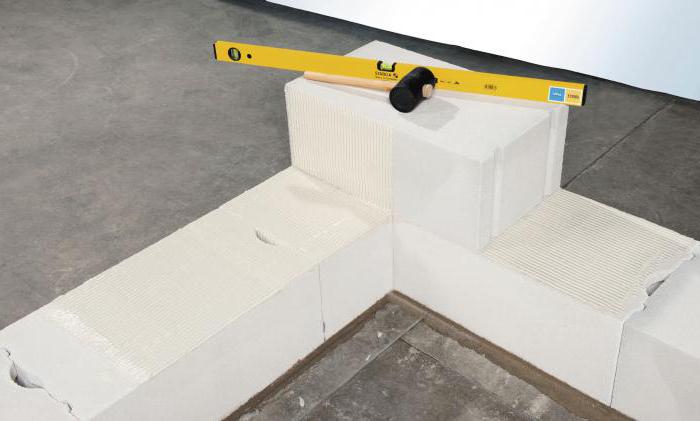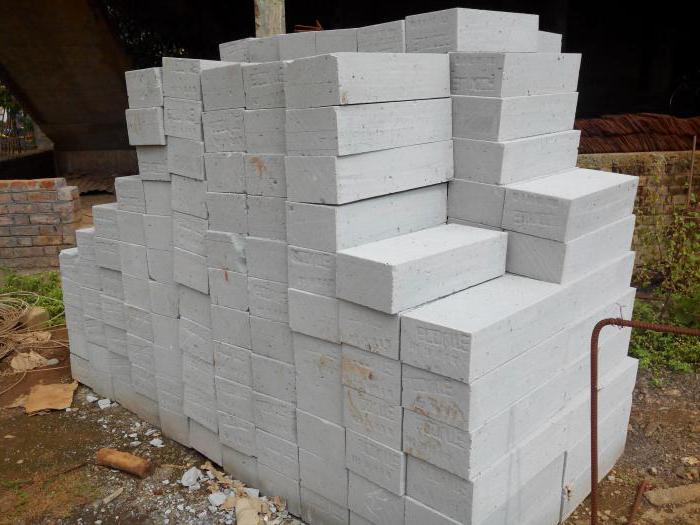Masonry: technology, tools, glue consumption
Construction shops today providean extensive range of materials and systems, a different price category and purpose. One of them is aerated concrete. It does not apply to new developments, but the greatest prevalence is observed in the last ten years. Because of the increasing popularity, more and more people are interested in the question of how to build gas concrete with their own hands.

Characteristics
The basis of aerated concrete is artificialcomponents pre-mixed in water, such as cement, lime, sand and gas-forming additives. The structure is characterized by the presence of many small cellular pores, which is why the blocks are characterized by a large void. The material is manufactured in the process of exposure to high temperatures and pressure, followed by curing in an autoclave. The cost of aerated concrete wall varies from 50 to 100 rubles apiece, depending on the size.
Blocks have a relatively small mass, so no special equipment is required. It is also possible to cut out any necessary shapes with a standard wood hacksaw.

disadvantages
This building material can not be calleduniversal, and many people prefer to use other methods of construction. This is due to the presence of a sufficient number of shortcomings, the main ones being the following:
- Friability. If the laying of aerated concrete is carried out in an area with seismic activity, it is worth remembering that ground movement can lead to the occurrence of dangerous cracks in the building. This can not but affect the interior decoration of the premises. Given that the surface of the material is easily damaged with a screwdriver, it becomes clear that it is necessary to use special fasteners for transferring loads during the fastening of furniture on wall structures and the creation of engineering systems.
- Hygroscopicity. Reduction of this property is almost impossible, due to the presence of a multitude of pores that promote active absorption of moisture from the environment. This is especially noticeable in regions with cold winters and hot summers. Hygroscopicity leads to an increase in the level of moisture in the building, and there is also the possibility of cracks on the wall surface, since the aerated concrete masonry absorbs water that starts to freeze at negative temperatures and expand, damaging the material.
The drawbacks mentioned above, although serious enough, can be dealt with. Suitable dowels for installation, external insulation and high-quality moisture insulation will eliminate them.
Materials and Tools
Before starting work, you need to prepare the following:
- cement solution;
- special adhesive;
- level;
- trowel;
- armature;
- rubber hammer;
- putty knife;
- grinding board.

Consumption of glue
In today's market there are manycompositions for work with materials characterized by a high level of moisture absorption, such as aerated concrete, whose dimensions are on the average 30x20x60 cm, and foam concrete. It is also possible to use solutions for processing and puttying the surfaces obtained.
The use of glue does not cause any difficulties. All components simply mix in the specified proportions. The work can be greatly simplified using a special drill with a mixer attachment.
When applying the material in a 1 cm layer,about 1.5 kg of dry composition for 1 square meter of blocks. In the presence of irregularities, the consumption of glue increases. It is desirable to use the mixture on a fine-grained basis, thereby reducing the likelihood of forming "cold bridges".
Advantages of the adhesive
The adhesive for the gas block has many advantages,which can not boast a cement mortar. Fractional sand and Portland cement contained in the composition, allow the distribution of the mixture with a thin layer, which allows to reduce the flow without changing the quality of the connecting characteristics. Adhesive properties and homogeneous filling are achieved by the addition of polymer components. Specific modifying additives provide moisture retention.
Glue hardening is characterized by lack ofshrinkage, it also has a water resistance, ductility and a sufficient level of adhesion. When using this material, the assembly of the unit should be carried out within 10-20 minutes, about 5 minutes is spent on correction. After preparation, the mixture must be consumed no later than three hours. Under conditions of low temperatures, the time of use of the formulation is reduced. During work during the winter period, special attention must be given to the thickness of the joints and the completeness of their filling.

Course of work
The technology of aerated concrete laying includesThe construction of the foundation of the building, which serves as the basis for the first row of blocks. The plinth should be located at a distance of 60-80 cm from the surface of the ground. Required laying waterproofing between aerated concrete and the base of construction.
For installation of the first row a solution is used,distributed on the waterproofing layer. Wall masonry of aerated concrete, regardless of the type of structure, is always made from the corner. To do this, each of them is pre-tensioned with a cord, which verifies the correct installation of all the units, while the construction level is additionally used for verification. The rubber hammer allows you to change the arrangement of the elements. It should be noted that in the glutinous mixture is not necessary when using blocks with the "groove-comb" system. The cost of aerated concrete of this type is about 100 rubles apiece. All irregularities should be removed after mounting each row, after which a grinding board for grouting is used.
The additional elements must be preliminarilysawn. Due to their composition, the work can be done with the help of an ordinary hacksaw. It is possible to use a band saw to ensure a more even cut. In this case, each time the accuracy should be measured with a square.
Installation of the next row is carried out after the lapse of2-3 hours after the completion of laying the bottom. Angular bandaging of blocks is an integral part of the work for each series. The rubber hammer periodically corrects the protruding elements.

Features
Masonry of aerated concrete requires careful adherencerules for pairing walls. In internal partitions, every second row should have a connection with the main wall structure, it is formed with the help of brackets or anchors, on which a perforated zinc-coated strip is fixed. Also do not forget about hydro and sound insulation of interior partitions.
Planning of slabs between floors shouldProvide support for the reinforced belt. It is performed on the last row of blocks and represents a concrete belt with reinforcement in the form of reinforcing elements. It carries many functions, among which: uniform separation of load from the roofing roofing system, protection of wall structures from the occurrence of cracks. To connect the walls to the roof, a Mauerlat is used, which is fixed on the armopoyas.
Reinforcement of the structure
Aerated concrete, the dimensions of which vary independing on the purpose and shape, for example, the dimensions of the direct block for the creation of partitions are 600х250х150 mm, it is quite brittle material and requires reinforcing works. The purpose of this process is to reduce the load that the roof of the building or interfloor overlap has. Reinforcement of the masonry provides additional strength of the structure and prolongs the service life.
Works are necessarily conducted on the first row, and also on every third. In addition, the belt, located under the interfloor overlapping, window and door openings is reinforced.
Cut out the crooked grooves along the perimeter of the wallmasonry for mounting reinforcement. Most often, two strips with a width of not more than 4 cm are sufficient. They should be 6-8 cm apart. For pouring, any semi-liquid solutions for the laying of aerated concrete are used, preliminaries are cleaned of dust. The mortar is completely submerged in the mortar, the diameter of which should be about 10 mm. A solution that has gone beyond the surface is immediately removed. Laying the next rows can be done immediately, without waiting for the solution to dry.

Works in the cold season
Wall masonry is desirable to implement with a positivetemperature, otherwise there are additional costs for heating the building material. The glue for the gas block contains a sufficient amount of water, because of what it quickly freezes in the cold and does not have time to fix the structure.
Creation of bearing walls with negativethe temperature can be carried out under the condition of an average daily level of at least -6 ° C, and there should also be a prolonged freezing of the structure and atmospheric precipitation. In this case, a solution containing antifreeze additives should be used. The finished mixture is consumed within 30 minutes, while warm water is used for cooking. On the applied layer of glue the blocks are immediately placed, not allowing interruptions. Otherwise, the mass icing and work on this place will become impossible. A film is used to cover the last row.

Cost and material retention
Blocks should be stored in suitable conditions forprevention of loss of technological properties and quality. If at least a month passes from the date of purchase to use, the factory packaging is not removed from the material, which protects it from the negative influence of the environment. It needs to be removed a few days before the work starts, so that excess moisture has evaporated.
The cost of laying aerocrete blocks is affectedexpenses for transportation, the properties of the material itself and the costs of construction. Also it is worth remembering about the volume of purchase and seasonality, which also have a significant impact.
The price of a cubic meter of material depends onmarking of blocks, strength indicators and is in the range of 2000-4500 rubles. Additional factors besides the purchased volume and time of the year include the availability of shares and the manufacturer.
</ p>>







